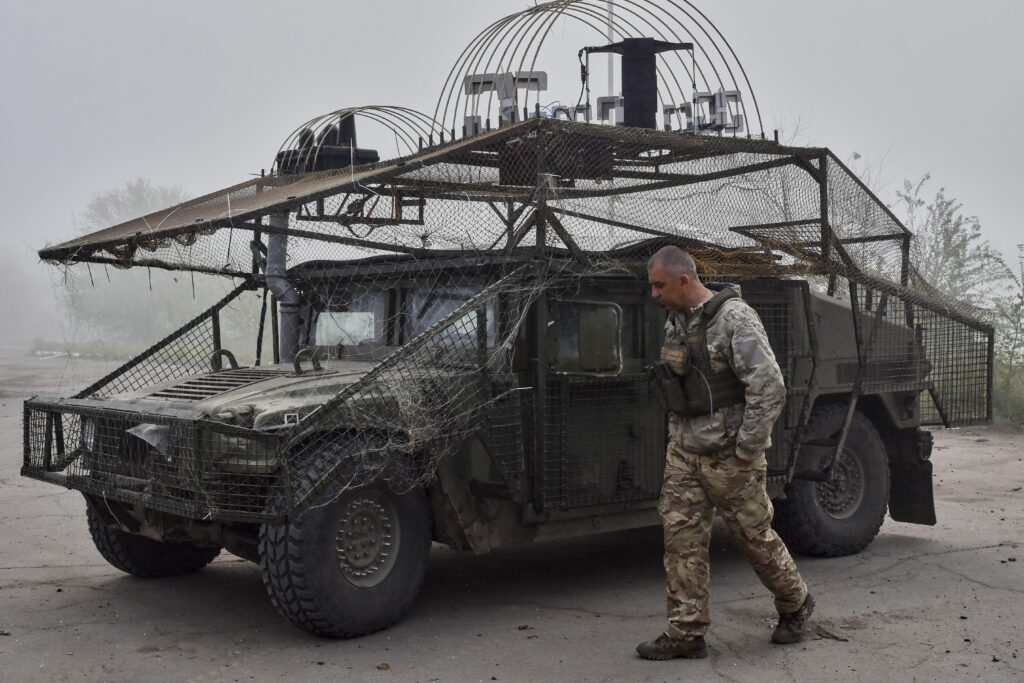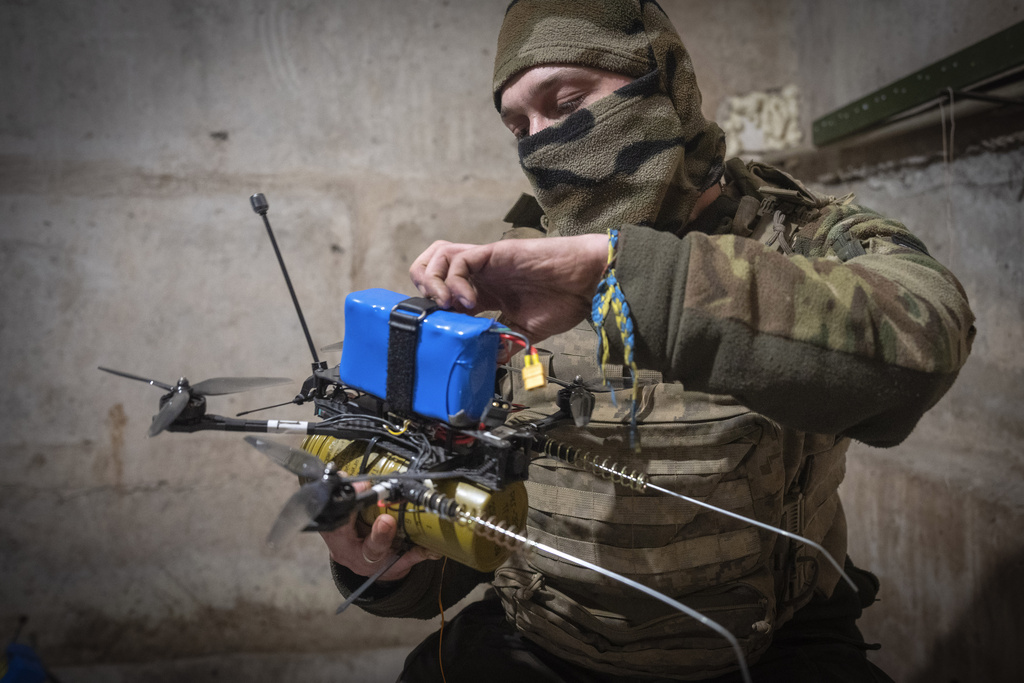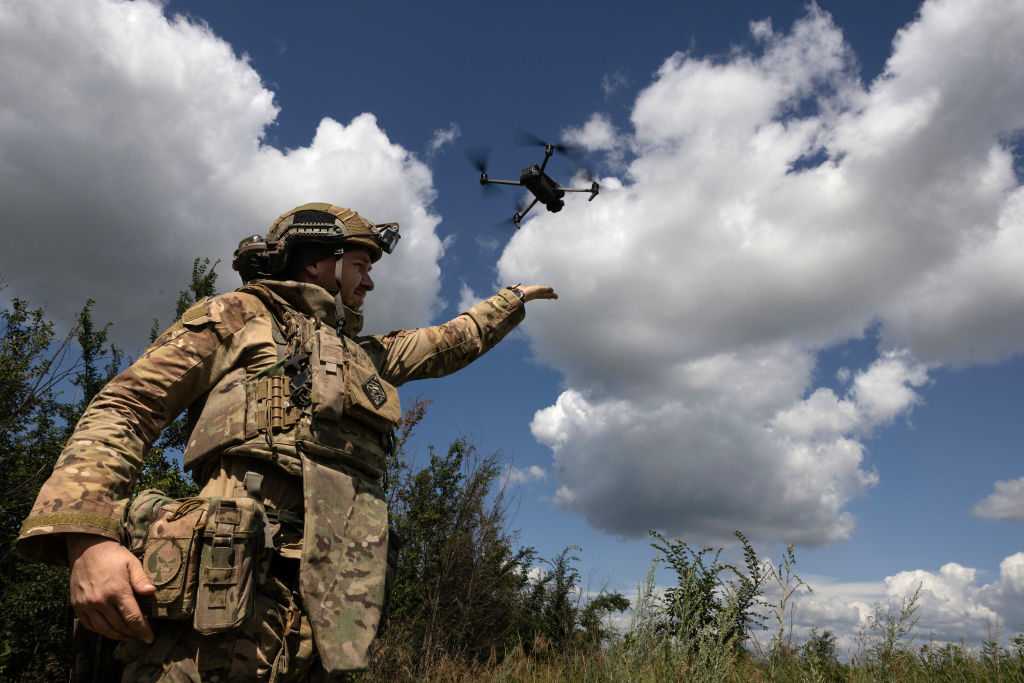Putin’s Close Call With Ukrainian Drones Spotlights New Technology Defining the Russia-Ukraine War
This year, Kyiv aims to build 4.5 million drones, almost 50 times America’s capacity.

President Putin flew by helicopter into a Ukrainian drone attack last week, in an apparent close call that illustrates the fast-changing face of the Russia-Ukraine war.
On a flight to Kursk region, bordering Ukraine, the Mr. Putin’s helicopter “was virtually at the epicenter of repelling a large-scale attack by the enemy’s drones,” a Russian air defense division commander, Yuri Dashkin, said Sunday, according to TASS news agency.
Both nations are racing furiously to develop game-changing weapons. Drone technology generations are now measured in months. This week, for the first time, a Ukrainian “mothership” drone flew into combat, deep inside Russia. It launched two kamikaze drones, then returned to base, reports Kyiv’s digital transformation minister, Mykhailo Fedorov.
Ukraine’s StratForce is testing its SmartPilot autonomous flight system. This uses a combination of advanced sensors and artificial intelligence. Without human intervention, these winged planes can fly into enemy territory, and then select and attack targets — all following programmed parameters and real-time Light Detection and Ranging readings.

Few Ukrainians or Russians display high hopes for a second round of peace talks scheduled for Monday at Istanbul. Instead, Russia is launching its fourth summer offensive, presumably hoping to strengthen its position in serious peace talks this fall. So far this year, Russia has advanced at the rate of only five square miles a day, according to Washington’s Institute for the Study of War. In two weeks, Russia’s toll of dead and wounded is expected to hit 1 million, according to a daily tally maintained by Ukraine’s military since Mr. Putin in February 2022 launched his full-bore attack.
Today, both countries race to produce thousands of drones guided by fiber optic wires. Immune to jamming by electronic warfare equipment, these drones are controlled through fiber threads no thicker than a strand of human hair. Spooling out as far as 10 miles, a thread, these drones give controllers clear battlefield views and deadly accuracy.
This spring, fiber optic drones helped Russia carry the day in its successful offensive to recapture the Kursk region. Ukrainian soldiers found their radio wave jamming equipment was useless. Soldiers could only move around on cloudy or windy days.
As their logistical supply road increasingly was cut by drones, Ukrainian drone operators noticed telltale tangles of glinting threads on the ground. Soldiers joked that they could only defend themselves with scissors. Today engineers are working on a solution: A killer drone that can track a fiber optic thread to its source.

These fiber optic drones are “expected to play a crucial role in Russia’s unfolding summer offensive,” a Henry Jackson Society research fellow, David Kirichenko, wrote Thursday for the Atlantic Council. “If Putin’s commanders can implement the fiber optic drone tactics that proved so successful in the Kursk region, they may be able to finally overcome Ukraine’s dogged defenses and achieve a long-awaited breakthrough.”
While Ukraine still lobbies President Trump for conventional military aid, the Pentagon and the rest of the West are largely bystanders in this shape-shifting drone war. Ukraine still needs artillery and tank shells, but drones now inflict about 70 percent of Russia’s casualties. This year, Ukraine aims to build 4.5 million drones, almost 50 times America’s capacity. Now, America, Britain, and France are racing to build their own factories, in some cases partnering with Ukrainian manufacturers.
If NATO ever tangles militarily with Russia, it will face a fast-evolving foe that pulls even with Ukraine in drone warfare. Last week Russia’s largest schoolbook publisher announced that it has partnered with Russian drone maker Geoscan to produce a textbook for technology classes this fall “Unmanned Aerial Vehicles: 8th and 9th Grades.” Part of a wider militarization of Russian society, the textbook is part of a plan to train 1 million Russian drone operators at more than 500 schools and 30 universities by 2030, Geoscan reports.
For its part, Ukraine’s army now runs contests, awarding more resources, including fiber optic drones, to drone teams that score the highest number of kills. In April, Ukrainian drone brigades reported hitting 83,000 Russian targets — largely soldiers, vehicles, radar stations, and artillery cannons. To defend against Russia’s summer offensive, Ukraine is crafting “drone walls” — 10-mile wide “kill zones” — along the 600-mile long front line.

On the battlefield, unmanned all-terrain vehicles now ferry food and ammunition to forward positions. In one case this month, one of these ‘robots with wheels’ extricated a wounded soldier, carrying him 10 miles to safety. Ukrainian journalist Nataliya Gumenyuk writes this week in the Atlantic: “Drones now guide artillery, deliver payloads, resupply units, and even map out minefields. They’re fast, cheap, adaptable — and built right at home.”
At sea, Ukraine, a nation without a navy, used maritime drones to break Russia’s naval blockade of Ukraine’s Odessa region grain ports. After losing about a quarter of its ships, Russia’s Black Sea fleet largely retreated from its historic home in Crimea to take refuge in Russian seaports guarded with steel nets.
In a surprise for Russia this spring, Ukraine placed anti-aircraft missiles on several Magura V7 maritime drones. In a world first, a Ukrainian naval drone patrolling the Black Sea shot down two Russian Su-30 fighter jets. Each was valued at $50 million.
Now both sides study British and Israeli laser anti-aircraft cannons that down drones for $5 a shot. President Zelensky told reporters at Kyiv on Tuesday: “We are also moving towards drone-to-drone interceptors.” He estimates that Russia produces about 300 long-range drones a day, triple Ukraine’s production. He added: “I would like to see us receive $30 billion to launch Ukrainian production at full capacity.”
His former military chief, Valerii Zaluzhnyi, said last week in a speech at Kyiv that Ukraine must use drones to wage a “high-tech war of survival” in order to “make the economic burden of the war unbearable for Russia.” He warned: “Where yesterday we were ahead of the enemy. The enemy has already outpaced us.” Only five percent of Ukraine’s 500 drone manufacturers are producing fiber optic drones.
Shifting focus from last winter’s attacks on oil refineries, Ukrainian drone operators hit over the last month 10 different Russian arms factories, several of them deep inside Russia. Although drones do not pack the explosive punch of rockets, they can set off fires or damage high-value fixed targets, such as parked war jets.
One target that Russian air defense guards zealously is a joint Russia-Iranian drone production factory at Yelabuga, Tatarstan, about 600 miles northeast of Ukraine. There, a $2 billion deal with Iran — partially paid in gold bars — is paying off with a second-generation, jet-propelled Russian version of Iran’s Shahed-136 drone.
“Russian drones now fly faster and at higher altitudes, beyond the reach of Ukraine’s mobile air defence groups,” reads a report released Thursday by the Washington-based global security research group. C4ADS. Carrying 200-pound payloads, these new drones have been recorded at 16,000 feet.
Communist China also helps Russia through production of military versions of civilian Mavic quadcopters assembled by DJI, the world’s largest drone maker. “Chinese Mavic is open for Russians, but is closed for Ukrainians,” Mr. Zelensky said Tuesday. “There are production lines on Russian territory where there are Chinese representatives.”
As for Mr. Putin flying 10 days ago in skies infested with Ukrainian drones, it is unclear if the Ukrainian military drone operators knew that Russia’s president was in the area. In what could be a clue, Mr. Zelensky and his wife, Olena, made a special purchase yesterday at Kyiv’s largest book fair, Arsenal Book Festival. Later, he wrote on his Telegram page: “Today, we purchased several publications for our library, including ‘To Kill a Tyrant. A History of Tyranny from Caesar to Gaddafi.’”

